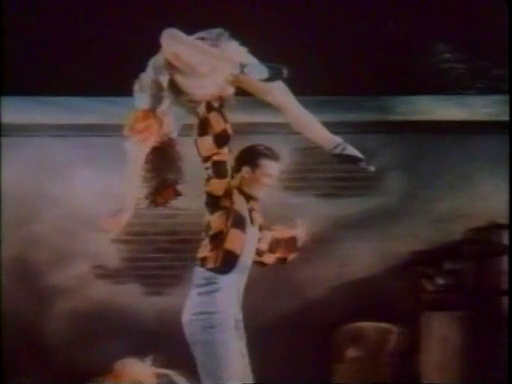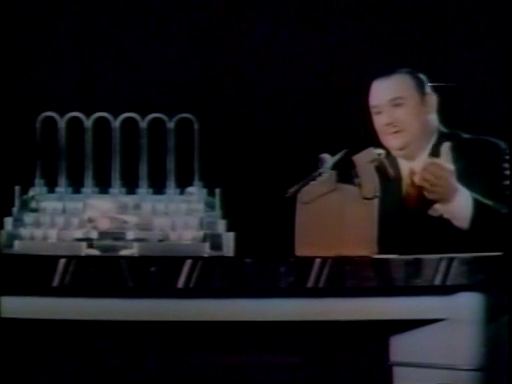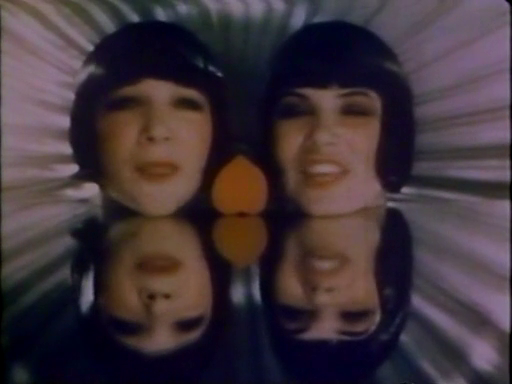“Oh, how I’d love to own a fish store!”
|

Synopsis:
Jazz band leader Paul Whiteman introduces a revue of musical and comedic acts.
|
|
Genres, Themes, Actors, and Directors:
Review:
This musical tribute to bandleader Paul Whiteman features some surprisingly creative camerawork for such an early cinematic outing, but is decidedly hit-and-miss in terms of its overall entertainment value. There’s an enjoyably risque comedic interlude about premarital sex that catches one by surprise, and it’s fun to see young Bing Crosby as one of The Rhythm Boys — but other numbers are deathly boring and dated. The primary value of this film lies in its historical relevance as a time capsule of Whiteman’s appeal to audiences at the time.
Note: The quote chosen to headline this review is indicative of how random the various vignettes are.
Redeeming Qualities and Moments:
- A few enjoyable and/or surprisingly risque sequences

- Some nifty special effects

- Fine two-strip cinematography

- Creative camerawork


Must See?
No, though it possesses some value as a time capsule.
Links:
|






2 thoughts on “King of Jazz, The (1930)”
First viewing. Not must-see.
This is (now) a curio indeed! And, for modern audiences, among the most mixed of mixed bags. Ultimately, it’s hardly rewarding at all – even as an historical document.
The format of a ‘musical revue’ is that it should offer something for everyone, or to suit various tastes. Maybe this film did that when it was released but now it mostly creaks.
What’s most surprising is, for a film called ‘The King of Jazz’…there’s no jazz!…at least not that I could detect. There’s certainly a mix of various musical styles – many of them now being along quaint lines – but very little that’s progressive. The main exception is the inclusion (midway) of Gershwin’s ‘Rhapsody in Blue’. ~a welcome addition because, well…it’s Gershwin (!) and it’s accompanied by some of the film’s most inventive visuals. (Intermittently, the film is valuable for its visual experimentation – which runs the risk of being negated by the bulk of the film’s content.)
Too much of the singing is of the style which featured women with very high-pitched voices (no doubt considered the height – as it were – of singing at the time) and men often with high-pitched voices and often wearing make-up applied as heavily as the women’s (no doubt intended to make them look young – when it unfortunately makes them look more like drag queens).
The dancing is also problematic here. For the most part, the style is very simplistic – revealing the job that would be cut out for choreographers in decades to come to show how much (more) the human body can achieve. In other words, the dance steps are very fundamental. On the plus side…a few sequences highlight some very athletic and acrobatic dancers (i.e., in the ‘Ragamuffin Romeo’ number).
One of the numbers – ‘I’d Like To Do Things For You’ – shows some comic relief…not when it’s first sung (as a schmaltz number), but when it continues with a separate couple and the song’s cheerful message is undone – since the second couple is one that regularly quarrels.
The sections involving dialogue skits mostly fall flat. The one I liked involves a female newspaper editor complaining to her female reporters that she *needs* ‘hot item’ stories – so one of the reporters reports a gun shooting that we hear just as she’s finishing reporting it.
‘The King of Jazz’ didn’t aspire to ‘a big finish’. Instead, the film concludes with a tribute to the ‘melting pot’ music of America – so we are quickly taken through a musical cultural mix that isn’t particularly memorable for any reason.
Other than its being a Peary title, I had never heard of this film (though I knew of Paul Whiteman from various other places). It will have some appeal for those interested in early talkies but otherwise…meh, more or less.
Watched it since if was about to get removed from my YouTube TV cloud DVR. Surprised to see a 1930 film I never heard of was filmed using two-color technicolor. This is really a time capsule of entertainment and singing styles from the past. One word can describe this film: trippy. It was nice to see a pre star Bing Crosby, and Rhapsody in Blue. Some of the numbers were interesting. The print I watched was beautifully reserved. With that said – count this as a film I’m glad I watched one time to see what once passed as entertainment, but I certainly wouldn’t call it a must watch. Now if only a film like this existed that showed classic blues and folk artists from this time period – that would be something.